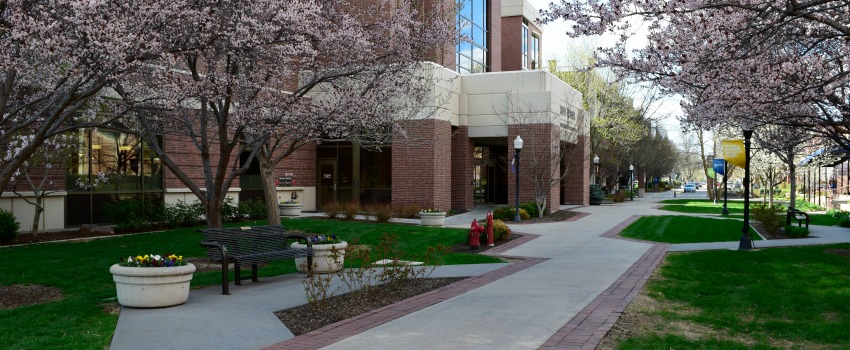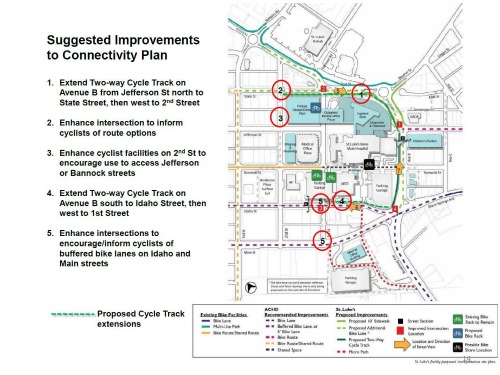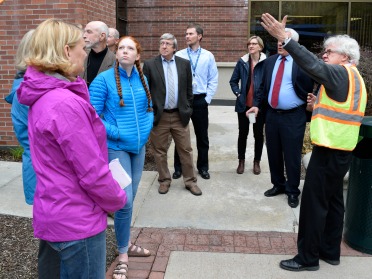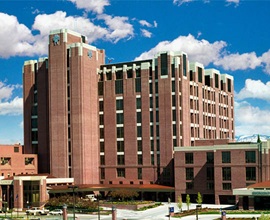St. Luke’s Works to Build Consensus on Bannock Corridor Design

St. Luke’s teamed up with Boise City leaders and community groups this week to continue working toward the best design of Bannock Street between Avenue B and 1st Street.
Over the last three days, one of the nation’s leading design and transportation consulting firms led seven listening meetings and a one-day design charrette. The goal was to gather input from a diverse group of stakeholders to better understand the various wants, needs, constraints, concerns and opportunities for the Bannock Corridor, then find common ground for its ultimate design and use.

The work sessions are part of the next phase of engagement for the St. Luke’s Downtown Master Plan and its incorporation of bike and pedestrian mobility features. The Health System is embarking on a $300 to $400 million development project, one of the largest construction projects ever to be completed in Boise and Idaho. Included in the design are significant improvements to pedestrian, bicycle and vehicle transportation infrastructure, and connectivity along streets and pathways around the Boise hospital campus.
The Bannock Corridor is one part of that complex integrated system. The paved brick pathway is surrounded by trees and runs between St. Luke’s main hospital and Mountain States Tumor Institute (MSTI). The space is currently used every day by employees as they make their way in and out of the hospital, and on lunch breaks. Patients and families also utilize the garden-like area as a respite zone for healing time away from the sterile hospital interior. Bannock also plays hosts to news conferences, community celebration events, displays, concerts, produce stands, fundraisers and more.
As part of the comprehensive public process surrounding the downtown development, St. Luke’s agreed to preserve public access with a 28-foot wide easement that “shall include a 10-foot dual use pathway.”
“Our current proposed design of the Bannock space is focused on our commitment to patient safety first, and reflective of the community feedback we’ve received through the numerous bicycle and pedestrian workshops we’ve held over the past three years,” said Theresa McLeod, St. Luke’s Director of Community Relations.
In order to meet the intent of the Memorandum of Understanding* and the Letter of Agreement** signed in March of 2016, Toole Design Group (TDG) was brought in to conduct the two-part process of engagement as a next step. St. Luke’s invited city leaders, neighborhood groups, students, non-profits, cycling and pedestrian advocates, physicians, and other interested groups to take part.
After conducting independent research on the current bicycle and pedestrian conditions, and evaluating past studies, TDG held small listening meetings Tuesday and Wednesday. All of the input gathered was then presented to the entire group Thursday during a Charrette held at St. Luke’s. Stakeholders also spent time out on Bannock Street to observe first-hand the physical conditions, behavioral patterns and quality of the open space experience.
The final phase of the charrette centered on design. Participants were asked to share their priorities for the design plan, and offer perspective on the pros and cons to opening the space to vehicles. The group was then led through a facilitated process to identify areas of agreement.

This combined model is one Peter Lagerwey says is successful. As TDG’s Project Manager and Facilitator, he developed and lead workshops at more than 200 locations.
“Charrettes are used where there is a desire to solve a complicated design problem. It’s an effective means of resolving potentially contentious planning and challenging design elements because of the involvement of a diverse set of stakeholders and interests,” Lagerwey explained. “Upon conclusion of the listening meetings and charrette, we often discover there is very little difference between what might have been perceived as competing interests. For example, safety often emerges as a common theme. Once there is a consensus that safety is important, the door is open for further conversations on how to design for safety.”
The result of this week’s multi-layered process was that the group agreed there is now enough consensus on the design to move forward and work together to develop the details for that space. Yet to be determined is how the space will operate, whether those operations are to include vehicles or not, or whether to potentially allow vehicles but restrict when they can access the space.
St. Luke’s West Region CEO Kathy Moore thanked the group for the time commitment they made to help solve this. “The conversation was intentional. We’re grateful to everyone who shared their perspective and participated actively. We don’t all have to agree, but we do have to be willing to come together and have dialogue, and there will be compromises that come as a result.”
Moore went on to add, “It’s truly St. Luke’s desire to be good neighbors and we all came to a good spot through this.”
The ultimate final design will require votes of approval from ACHD and the City of Boise.
“St. Luke’s will continue to invite the stakeholders to participate in various way to ensure the project stays on track and work is not repeated,” said McLeod. “We look forward to continuing to work with the city and community as the overall design progresses.”
*Memorandum of Understanding: “will include, without limitation: a discussion of the designs of those transportation elements to be constructed or installed within the Bannock Corridor (between Avenue B and 1st Street). The discussion will focus on refining Bannock Corridor mitigation element designs, including (without limitation) the twenty eight foot (28’) wide public access easement, which includes a ten foot (10’) wide dual use (pedestrian and bicyclist) pathway.”
**Letter of Agreement: “The Bannock Corridor between Avenue B and 1st Street shall be preserved for public access by a 28-foot wide easement within which no further building construction is allowed and shall include a 10-foot dual use pathway as depicted in the Supplemental Narrative [of the Master Plan], dated March 2015, that is open to the public and cyclists. The corridor may also be designed to allow automobile access if deemed appropriate by the City of Boise. Final decisions and/or design will emerge through a series of meetings and planning sessions as described in [the Master Plan]. The easement shall be as approved by the Boise City Attorney and shall be maintained by St. Luke’s.”
About The Author

Anita Kisseé was the Treasure Valley public relations manager for St. Luke’s Health System.

